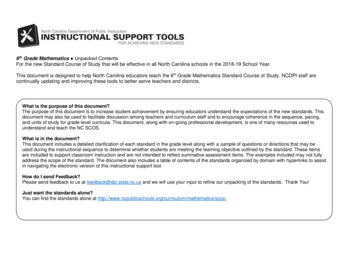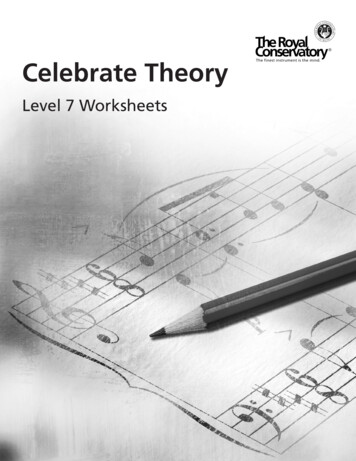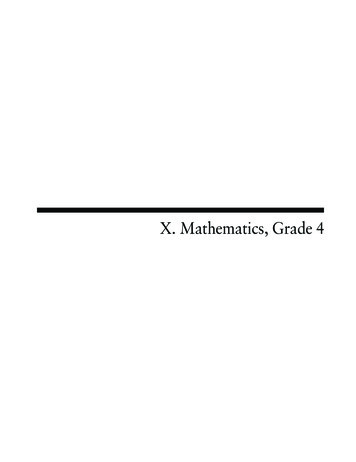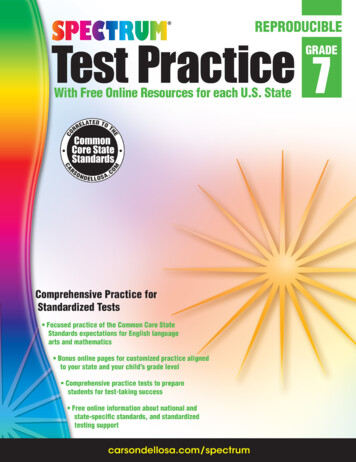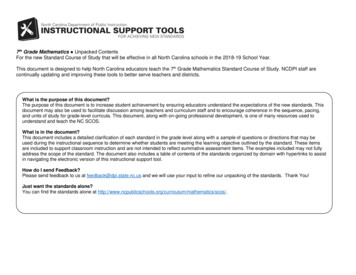
Transcription
7th Grade Mathematics Unpacked ContentsFor the new Standard Course of Study that will be effective in all North Carolina schools in the 2018-19 School Year.This document is designed to help North Carolina educators teach the 7th Grade Mathematics Standard Course of Study. NCDPI staff arecontinually updating and improving these tools to better serve teachers and districts.What is the purpose of this document?The purpose of this document is to increase student achievement by ensuring educators understand the expectations of the new standards. Thisdocument may also be used to facilitate discussion among teachers and curriculum staff and to encourage coherence in the sequence, pacing,and units of study for grade-level curricula. This document, along with on-going professional development, is one of many resources used tounderstand and teach the NC SCOS.What is in the document?This document includes a detailed clarification of each standard in the grade level along with a sample of questions or directions that may beused during the instructional sequence to determine whether students are meeting the learning objective outlined by the standard. These itemsare included to support classroom instruction and are not intended to reflect summative assessment items. The examples included may not fullyaddress the scope of the standard. The document also includes a table of contents of the standards organized by domain with hyperlinks to assistin navigating the electronic version of this instructional support tool.How do I send Feedback?Please send feedback to us at feedback@dpi.state.nc.us and we will use your input to refine our unpacking of the standards. Thank You!Just want the standards alone?You can find the standards alone at ics/scos/.
North Carolina 7th Grade StandardsRatio and ProportionalRelationshipsAnalyze proportionalrelationships and use themto solve real-world andmathematical problems.NC.7.RP.1NC.7.RP.2NC.7.RP.3Standards for Mathematical PracticeExpressions &The Number SystemEquationsApply and extend previousunderstandings ofoperations with fractions toadd, subtract, multiply, anddivide rational numbers.NC.7.NS.1NC.7.NS.2NC.7.NS.3NC Department of Public InstructionUse properties ofoperations to generateequivalent expressions.NC.7.EE.1NC.7.EE.2Solve real-world andmathematical problemsusing numerical andalgebraic expressions,equations, andinequalities.NC.7.EE.3NC.7.EE.42GeometryDraw, construct, anddescribe geometricalfigures and describe therelationships betweenthem.NC.7.G.1NC.7.G.2Solve real-world andmathematical problemsinvolving angle measure,area, surface area, andvolume.NC.7.G.4NC.7.G.5NC.7.G.6Statistics & ProbabilityUse random sampling todraw inferences about apopulation.NC.7.SP.1NC.7.SP.2Make informal inferencesto compare twopopulations.NC.7.SP.3NC.7.SP.4Investigate chanceprocesses and develop,use, and evaluateprobability models.NC.7.SP.5NC.7.SP.6NC.7.SP.7NC.7.SP.87th Grade Unpacking Document Rev. June 2018
Standards for Mathematical PracticePractice1. Make sense of problemsand persevere in solvingthem.Explanations and ExamplesIn grade 7, students solve problems involving ratios and rates and discuss how they solved the problems. Students solve realworld problems through the application of algebraic and geometric concepts. Students seek the meaning of a problem and lookfor efficient ways to represent and solve it. They may check their thinking by asking themselves, “What is the most efficient wayto solve the problem?”, “Does this make sense?”, and “Can I solve the problem in a different way?”.2. Reason abstractly andquantitatively.In grade 7, students represent a wide variety of real world contexts through the use of real numbers and variables inmathematical expressions, equations, and inequalities. Students contextualize to understand the meaning of the number orvariable as related to the problem and decontextualize to manipulate symbolic representations by applying properties ofoperations.In grade 7, students construct arguments using verbal or written explanations accompanied by expressions, equations,inequalities, models, and graphs, tables, and other data displays (i.e. box plots, dot plots, histograms, etc.). The studentsfurther refine their mathematical communication skills through mathematical discussions in which they critically evaluate theirown thinking and the thinking of other students. They pose questions like “How did you get that?”, “Why is that true?”, “Doesthat always work?”. They explain their thinking to others and respond to others’ thinking.In grade 7, students model problem situations symbolically, graphically, tabularly, and contextually. Students form expressions,equations, or inequalities from real world contexts and connect symbolic and graphical representations. Students explorecovariance and represent two quantities simultaneously. They use measures of center and variability and data displays (i.e.box plots and histograms) to draw inferences, make comparisons and formulate predictions. Students use experiments orsimulations to generate data sets and create probability models. Students need many opportunities to connect and explain theconnections between the different representations. They should be able to use all of these representations as appropriate toany problem’s context.Students consider available tools (including estimation and technology) when solving a mathematical problem and decide whencertain tools might be helpful. For instance, students in grade 7 may decide to represent similar data sets using dot plots withthe same scale to visually compare the center and variability of the data. Students might use physical objects or applets togenerate probability data and use graphing calculators or spreadsheets to manage and represent data in different forms.In grade 7, students continue to refine their mathematical communication skills by using clear and precise language in theirdiscussions with others and in their own reasoning. Students define variables, specify units of measure, and label axesaccurately. Students use appropriate terminology when referring to rates, ratios, probability models, geometric figures, datadisplays, and components of expressions, equations or inequalities.Students routinely seek patterns or structures to model and solve problems. Students apply properties to generate equivalentexpressions (i.e. 6 2𝑥 3(2 𝑥) by distributive property) and solve equations (i.e. 2𝑐 3 15, 2𝑐 12 by subtractionproperty of equality), 𝑐 6 by division property of equality). Students compose and decompose two- and three-dimensionalfigures to solve real world problems involving scale drawings, surface area, and volume. Students examine tree diagrams orsystematic lists to determine the sample space for compound events and verify that they have listed all possibilities.In grade 7, students use repeated reasoning to understand algorithms and make generalizations about patterns. Duringmultiple opportunities to solve and model problems, they may notice that 𝑎/𝑏 𝑐/𝑑 𝑎𝑑/𝑏𝑐 and construct other examples andmodels that confirm their generalization. They extend their thinking to include complex fractions and rational numbers. Studentsformally begin to make connections between covariance, rates, and representations showing the relationships betweenquantities. They create, explain, evaluate, and modify probability models to describe simple and compound events.Return to: Standards3. Construct viable argumentsand critique the reasoning ofothers.4. Model with mathematics.5. Use appropriate toolsstrategically.6. Attend to precision.7. Look for and make use ofstructure.8. Look for and expressregularity in repeatedreasoning.NC Department of Public Instruction37th Grade Unpacking Document Rev. June 2018
Ratio and Proportional ReasoningAnalyze proportional relationships and use them to solve real-world and mathematical problems.NC.7.RP.1 Compute unit rates associated with ratios of fractions to solve real-world and mathematical problems.ClarificationChecking for Understanding11This standard asks students to understand the concepts of a unit rate inJulia walks mile in each hour. She continues to walk at the same pace.22proportional relationships. This concept will allow students to write equations,a) What unit rate would be needed to find how many miles Julia walked ifgraph and compare proportional relationships.we know the number of hours?b) What unit rate would be needed to find how many hours Julia walked ifthIn 6 grade, students learned to find the multiplicative relationships within awe know how far she walked?ratio, the rate, and they explored the concepts of independent and dependent1c) If Julia walked for 1 hours, how far did Julia walk?variables. Students also learned that equivalent ratios also had equivalent3d) If Julia walked for 5.2 miles, how long did Julia’s walk take?rates.In 7th grade, students build on this understanding to: Find the appropriate rate based on context. Rewrite any rate as a unit rate. Know that a rate can be used to express all of its associatedequivalent ratios.11If a gallon of paint covers of a wall, continuing at this rate how much paint26is needed for the entire wall?Ratios in 7th grade can include fractions and decimals, which may lead to𝑎students working with complex fractions, a fraction in the form 𝑏𝑐 . It is important𝑑for students to interpret a complex faction as the division of two fractions.Emily leaves her house at exactly 8:25 am to bike to her school, which is 3.42 milesaway. When she passes the post office, which is ¾ miles away from her home, shelooks at her watch and sees that it is 30 seconds past 8:29 am.If Emily’s school starts at 8:50 am, can Emily make it to school on time withoutincreasing her rate of speed? Show and/or explain the work necessary to support youranswer.Taken from : SBAC Mathematics Practice Test Scoring Guide Grade 7 p. 36NC Department of Public Instruction47thReturn to: StandardsGrade Unpacking Document Rev. June 2018
Analyze proportional relationships and use them to solve real-world and mathematical problems.NC.7.RP.2 Recognize and represent proportional relationships between quantities.a. Understand that a proportion is a relationship of equality between ratios.o Represent proportional relationships using tables and graphs.o Recognize whether ratios are in a proportional relationship using tables and graphs.o Compare two different proportional relationships using tables, graphs, equations, and verbal descriptions.b. Identify the unit rate (constant of proportionality) within two quantities in a proportional relationship using tables, graphs, equations, and verbaldescriptions.c. Create equations and graphs to represent proportional relationships.d. Use a graphical representation of a proportional relationship in context to:o Explain the meaning of any point (x, y).o Explain the meaning of (0, 0) and why it is included.o Understand that the y-coordinate of the ordered pair (1, r) corresponds to the unit rate and explain its meaning.ClarificationChecking for UnderstandingIn 6th grade, students worked to understand equivalent ratios and use them Determine which of the following tables represent a proportional relationship?to solve problems. In working with ratios, students focused on using ratesExplain your reasoning.and scale factors to find equivalent ratios. 7th grade builds on theseA.B.C.concepts, with the unit rate being used to determine proportionality,compare different proportional relationships, and to create differentrepresentations of the proportional relationships.D.Understand that a proportion is a relationship of equality betweenratios.Student represent given proportional relationships with tables and graphs.Find the unit rate, when 𝑥 1, of each proportional relationship identified aboveStudents determine the characteristics that remain consistent inand describe how you see the unit rate in the table.proportional relationships, such as the unit rate and inclusion of the origin.Students determine a proportional relationship by: Creating tables to analyze the multiplicative relationshipsbetween the quantities (the rate) and determine theirThe graph shows a proportional relationshipconsistency.between the number of gallons of gasoline used Creating graphs to visually verify a constant rate as a straight(g) and the total cost of gasoline (c).line through the corresponding coordinates and the origin.As students build on the concept of proportionality, they compare differentproportional relationships in various representations that may include,tables, graphs, equations, and verbal descriptions. Students compare theunit rates of the different proportional relationships. Students discuss whenit is and when it is not appropriate to compare proportional relationships.For example, it is not usually appropriate to compare proportionalrelationships from different contexts or some situations with different units.Find the unit rate (r). Using the value of r, write anequation in the form of 𝑐 𝑟𝑔 that represents therelationship between the number of gallons ofgasoline used (g) and the total cost (c).Taken from: SBAC Mathematics Practice Test ScoringGuide Grade 7 p. 31Students will accomplish this by examining the characteristics of eachproportional relationship and describing the similarities and differences.Students may change the representation of the proportional relationships toassist with their analysis. Students use the unit rates of each proportion toNC Department of Public Instruction57th Grade Unpacking Document Rev. June 2018
Analyze proportional relationships and use them to solve real-world and mathematical problems.NC.7.RP.2 Recognize and represent proportional relationships between quantities.a. Understand that a proportion is a relationship of equality between ratios.o Represent proportional relationships using tables and graphs.o Recognize whether ratios are in a proportional relationship using tables and graphs.o Compare two different proportional relationships using tables, graphs, equations, and verbal descriptions.b. Identify the unit rate (constant of proportionality) within two quantities in a proportional relationship using tables, graphs, equations, and verbaldescriptions.c. Create equations and graphs to represent proportional relationships.d. Use a graphical representation of a proportional relationship in context to:o Explain the meaning of any point (x, y).o Explain the meaning of (0, 0) and why it is included.o Understand that the y-coordinate of the ordered pair (1, r) corresponds to the unit rate and explain its meaning.ClarificationChecking for Understandingmake appropriate comparison statements and to draw conclusions. InA landscaper is hired to take care of the lawn and shrubs around the house. Thetables and graphs, students can use common values to make comparisons. landscaper claims that the relationship between the number of hours worked andthe total work fee is proportional. The fee for 4 hours of work is 140.Identify the unit rate (constant of proportionality) within two quantities a) Which of the following combinations of values for thein a proportional relationship using tables, graphs, equations, andlandscaper’s work hours and total work fee support the claimverbal descriptions.that the relationship between the two values is proportional?Students will expand upon their understanding of rate from 6th grade tob) Write an equation that describes the proportional relationship.understand that in proportional relationships every ratio in that relationshipwill have the same rate, or unit rate.This unit rate is sometimes referred to as the constant of proportionality.c) What is the relationship between your answers for part a and the equationThis is because in a proportional relationship, the rate is unchanging, oryou wrote for part b?constant even as the quantities increase or decrease by the scale factor.d) What is the relationship between your non-answers for part a and theThis is the most important characteristic to be identified in a proportionalequation you wrote for part b?relationship.Create equations and graphs to represent proportional relationships.As each ratio produces two rates, each proportional relationship can berepresented with two equations and two graphs, with the exception of ratiosin a 1:1 relationship. Students will need to use the context to determinewhich rate, or constant of proportionality, is appropriate to each situation.Using the rate, or constant of proportionality, students can generalize theproportional relationship between the quantities to create a two-variableequation that can represent the entire proportional relationship in context.Students graph proportional relationships on the coordinate plane using theunit rate. Students will determine the appropriateness between plottingpoints and drawing a line based on the characteristics of the quantitiesinvolved. Students solve problems using generated equations. In 7th grade,the term slope and the slope formula are inappropriate, as the focus shouldremain on the multiplicative relationships.NC Department of Public InstructionThe school bus driver follows the same route to pick students up in the morningand to drop them off in the afternoon. Because of traffic, the afternoon drive takes1.5 times as long as the morning drive.a) Write an equation that represents the relationship between the number ofminutes m, of the morning drive, to the total number of minutes, t, that the busdriver spends picking up and dropping off students each day.b) Using the unit rate, graph the equation on a coordinate plane. On your graph,should the points be connected to make a line? Explain.67th Grade Unpacking Document Rev. June 2018
Analyze proportional relationships and use them to solve real-world and mathematical problems.NC.7.RP.2 Recognize and represent proportional relationships between quantities.a. Understand that a proportion is a relationship of equality between ratios.o Represent proportional relationships using tables and graphs.o Recognize whether ratios are in a proportional relationship using tables and graphs.o Compare two different proportional relationships using tables, graphs, equations, and verbal descriptions.b. Identify the unit rate (constant of proportionality) within two quantities in a proportional relationship using tables, graphs, equations, and verbaldescriptions.c. Create equations and graphs to represent proportional relationships.d. Use a graphical representation of a proportional relationship in context to:o Explain the meaning of any point (x, y).o Explain the meaning of (0, 0) and why it is included.o Understand that the y-coordinate of the ordered pair (1, r) corresponds to the unit rate and explain its meaning.ClarificationChecking for UnderstandingUse a graphical representation of a proportional relationshipKell works at an after-school program at an elementary school. The table belowStudents interpret the meaning of coordinates, including the origin, plottedshows how much money he earned every day last week.as part of a proportional relationships. Students explain why the origin isincluded in all proportional relationship.Students use the context of the situation to determine if the quantities arediscrete or continuous and will only draw a line connecting the coordinatesif both quantities are continuous. A continuous quantity has the ability to beMariko has a job mowing lawns that pays 7 per hour.continuously divided into smaller parts. For example, the number of dogs isa) Who would make more money for working 10 hours? Explain or shownot a continuous quantity as you cannot have ½ a dog, so a line would notwork.be appropriate. However, a minute is a continuous quantity.b) Draw a graph that represents y, the amount of money Kell would makefor working x hours, assuming he made the same hourly rate he wasTables, equations and graphs of proportional relationshipsmaking last week.Students alsoc) Using the same coordinate plane, draw a graph that represents y, theexplain how theamount of money Mariko would make for working x hours.coordinate (1,r)d) How can you see who makes more per hour just by looking at therelates to thegraphs? Explain.Taken from Illustrative Mathematics: Who Has the Best Job?proportionalrelationship and itscorrespondingequation and table.Select the phrase from the box to make true statements. Be prepared to justifyStudents recognize that the r is theyour answer.multiplicative relationship between the xgreater than In a proportional relationship, if the unit rate is 1,and y coordinates of the ordered pairs.equal tothe value of the output will be the value of theless thaninput.In the graph and in the table, 1 and r form a ratio. If the scale factor of x is When comparing proportional relationships, if the unit ratemultiplied to this ratio, the ratio of x and rx is produced. This means that if xof first relationship is the unit rate of the second, the value of theis the input, then rx is the output.output of the first relationship will be the value of the output of theThis produces the proportional relationship equation, 𝑦 𝑟𝑥.second relationship for the same input value.Return to: StandardsNC Department of Public Instruction77th Grade Unpacking Document Rev. June 2018
Analyze proportional relationships and use them to solve real-world and mathematical problems.NC.7.RP.3 Use scale factors and unit rates in proportional relationships to solve ratio and percent problems.ClarificationChecking for UnderstandingIn this standard, students are expected to use proportional reasoning toZoomy is a racing garden snail. In a snail race, the snails are given one minute tosolve problems. Fraction and decimals may be used at all stages of thetravel as far as they can. The distance traveled is then measured in feet toproblems, and the problems may require multiple steps to find an answer. determine the winner. According to internet resources, a garden snail’s top speed isThrough reasoning and repeated exposure, students may develop an0.029 mph. If Zoomy traveled at top speed, how many feet could Zoomy travelalgorithmic approach to solving certain problem types. These approaches during the race? (1 𝑚𝑖 5280 𝑓𝑡)and formulas are not an expectation of the standard.This standard encompasses many problem types that include but are notlimited to: converting rates to different unitsThere were 70 employees working at a rental company. This year the number of percent increase and decreaseemployees increased by 10 percent. How many employees work for the rental creating and interpreting circle graphscompany his year?Converting Rates to Different UnitsIn 6th grade, students converted a single unit of measurement to adifferent unit of measurement. In 7th grade, students will be asked toconvert both units in a rate to different units. Students are expected touse scale factors and unit rates to make the conversions. Uncommonconversion ratios should be provided. Dimensional analysis is not anexpectation of this standard.Percent Increase and DecreaseStudents build upon the understanding of a percent as a ratio to solvemore complex percent problems. This requires students to understandthe effects on a product when multiplying a number by 1, a number lessthen 1, and a number greater then 1. Students are expected to use scalefactors and unit rates to solve percent problems. While students shouldavoid “rules” or formulaic approaches, students should see the patternand know that at percent increase or decrease is the proportionalrelationship between the initial value and the new value.Students know what terms may suggest a percent increase or decrease.Some of these terms include: tax, tip, commission, fee, discount, sale,mark up, and mark down. Students may be asked to answer questionsthat require multiple percent increases and decreases.For example: Abraham is taking his mother out to a restaurant for aMother’s Day dinner. He orders a meal that cost 12.99 and his momorders a meal for 14.79. They both order a drink for 2.75 each. Fortheir meal, there will be a 7.5% tax and Abraham plans to leave a15% tip for the server. How much will the entire meal cost?In 1980, the populations of Town A and Town B were 5,000 and 6,000, respectively.The 1990 populations of Town A and Town B were 8,000 and 9,000, respectively.a) Brian claims that from 1980 to 1990 the populations of the two towns grew bythe same amount. Use mathematics to explain how Brian might have justifiedhis claim.b) Darlene claims that from 1980 to 1990 the population of Town A grew more.Use mathematics to explain how Darlene might have justified her claim.NAEP – Released Item (2013) Question ID: 1996-8M12 #5 M069601A shirt is on sale for 40% off. The sale price is 12.a) How much was the discount?b) Write an equation that shows the relationship between the original priceand the amount paid taking into an account an 8.5% sales tax.There are multiple answers to this question depending on if the tip isdetermined before or after tax. The key is to listen to student reasoning.NC Department of Public Instruction87th Grade Unpacking Document Rev. June 2018
Analyze proportional relationships and use them to solve real-world and mathematical problems.NC.7.RP.3 Use scale factors and unit rates in proportional relationships to solve ratio and percent problems.ClarificationChecking for UnderstandingGiven the appropriate information, students may be asked to find theA car dealer is calculating the list price for a used car. The dealer takes the initialoriginal amount, a new amount, or the percent of change.price of the car and adds 259 dollars for cleaning and shipping the car to thedealer. The dealer then increases that price by 25% for the dealer’s profit. ThatCreating and Interpreting Circle Graphsprice is then increased again by 10% for the salesperson’s commission.In 6th grade, students learned to interpret part-to-total ratios as percents.a) If a used car is initially priced 10,000, what will be the list price for this car?In 7th grade, students will extend this interpretation to another commonb) Write an equation that shows the relationship between the initial price andpart-to-total ratio, degrees. Students first used degrees to make andthe list price.measure angles in 4th grade. This will be the students first exposureinterpreting the measure of an angle with a ratio, in which 1 degree is1/360 of a circle.The circle graph shows the number of cell phones sold at a local store.Students interpret a degree as being an equivalent ratio to a percent. The The darker shaded portion shows the number ofrelationship between percents and degrees allows categorical data thatcell phones that were sold with an unlimited dataform part-to-total relationships to be represented as sectors of a circle.plan. A total of 2,712 cell phones were sold.Given appropriate information, students:a) Using the circle graph, approximately how find missing values (data, percents, or degrees)many cell phones were sold with an unlimited create a circle graphdata plan? interpret a circle graph and use that information to solveb) What percent of the cell phone cells are soldproblemswithout an unlimited data plan?Students collected the following data about the students’ haircolor in their school.Create a circle graph that illustrate the data in the table. Labeleach part of the circle graph with the correct hair color andthe percent of the whole each part represents.Return to: StandardsNC Department of Public Instruction97th Grade Unpacking Document Rev. June 2018
The Number SystemApply and extend previous understandings of operations with fractions to add, subtract, multiply, and divide rational numbers.NC.7.NS.1 Apply and extend previous understandings of addition and subtraction to add and subtract rational numbers, using the properties of operations, anddescribing real-world contexts using sums and differences.ClarificationChecking for UnderstandingIn 6th grade, students learned to add and subtract integers between -20 and 20 Evaluate the following expressions:1using number lines and other models. In 7th grade, students expand upon thisb) 54.17 3.89a) 5 ( 3.25)2understanding to include all rational numbers.11c) 283 ( 35)d) 4 ( 6 )Students understand that the properties of operations learned with whole43numbers in elementary apply to rational numbers. Those properties include theidentity, commutative and associative properties. Students rewrite subtractionas addition to apply properties as needed. Students apply their knowledge ofJustin is trying to determine if he has enough money to buy a new video game.addition and subtraction of rational numbers to describe real-world contextsThe game cost 54.79. He started the day with 210 in his bank account.and develop a process, their own rules, to add and subtract rational numbers.Looking at his receipts, he has spent 87.35 at a clothing store, 42.79 at aparty store, and 25.68 at a gas station. Does he have enough money to buythe video game? Beyond estimating, explain your answer mathematically.Return to: StandardsApply and extend previous understandings of operations with fractions to add, subtract, multiply, and divide rational numbers.NC.7.NS.2 Apply and extend previous understandings of multiplication and division.a. Understand that a rational number is any number that can be written as a quotient of integers with a non-zero divisor.b. Apply properties of operations as strategies, including the standard algorithms, to multiply and divide rational numbers and describe the product andquotient in real-world contexts.c. Use division and previous understandings of fractions and decimals.o Convert a fraction to a decimal using long division.o Understand that the decimal form of a ratio
7th Grade Mathematics Unpacked Contents For the new Standard Course of Study that will be effective in all North Carolina schools in the 2018-19 School Year. This document is designed to help North Carolina educators teach the 7th Grade
